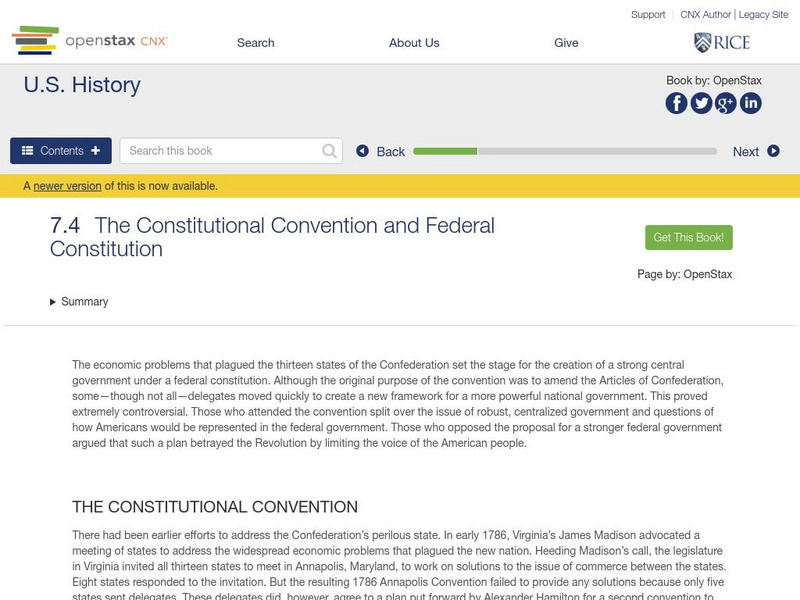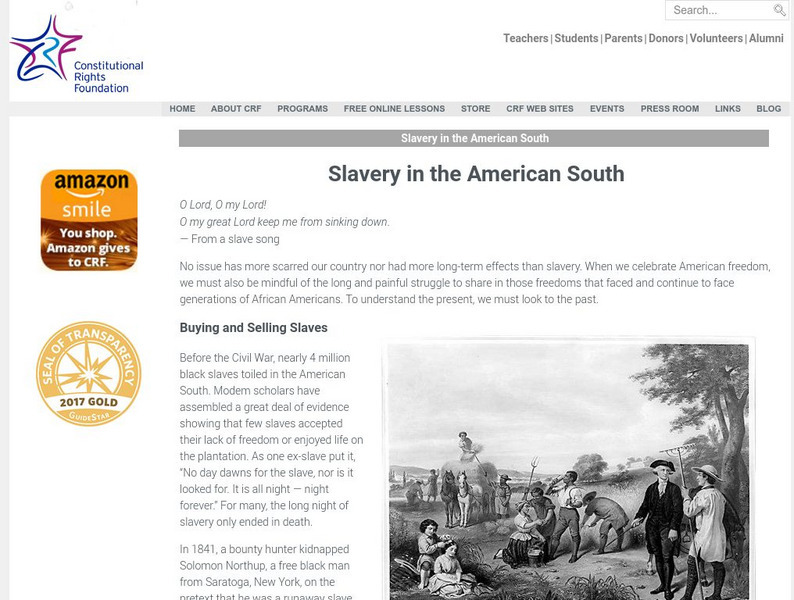Hi, what do you want to do?
Curated OER
Civil War and Reconstruction
Fourth graders investigate the Civil War by researching the state of Virginia. For this US History lesson, 4th graders identify Abraham Lincoln, James Chestnut and Fort Sumter, and discuss their roles in the start of the Civil...
Curated OER
Social Studies Test B-Grade 5
For this grade 5 social studies test worksheet, 5th graders complete a 30 question multiple choice quiz covering a variety of grade 5 concepts.
Curated OER
The Lincoln-Douglas Debates of 1858
Eleventh graders examine transcripts of the 1858 Lincoln-Douglas debates and create a platform for each candidate in the 1858 Senate race.
Curated OER
Jim Crow Laws and The American South
Learners explore how Jim Crow laws affected the lives of people living in the south during pre and post-Civil Rights. Using a various research methods, students research various aspects of the Jim Crow south and complete a graphic...
Curated OER
Our Heritage: American!
In this poetry worksheet, students read the poem "Our Heritage: American!" and then answer 4 questions about the poem. There are 2 questions at the bottom of the worksheet for discussion.
Curated OER
1856-1865: Abolitionists and the Civil War
Pupils discover philanthropic acts of the Civil War era. In this service learning lesson, students research Underground Railroad literature, Reconstruction Amendments, and acts of philanthropy during the Civil War era.
Curated OER
Fighting for Democracy, Fighting for Me
Students consider how African American responded to social injustice. In this social injustice lesson, students compare and contrast the visions of Booker T. Washington and W.E.B. DuBois for obtaining civil rights for African Americans.
Curated OER
Segregated America
Students investigate Jim Crow laws. In this segregation lesson, students analyze images that display American segregation. Students use the provided questions to aid them in their evaluation of the images.
Curated OER
Reconstruction (1865–1877)
In this online interactive history worksheet, students respond to 7 short answer and essay questions about the causes and effects of Reconstruction following the American Civil War.
Curated OER
Conservation: California Quarter Reverse
Students examine the California quarter reverse and discuss conservation measures. They discover the concept of conservation by a snack-eating experimen and relate it to John Muir's conservation interests. After evaluating the design...
Curated OER
Mississippi and Civil Rights
In this Mississippi Civil Rights worksheet, students read 9 paragraphs about the history of civil rights in Mississippi. Worksheet has no other associated activities.
Curated OER
Arkansas and the Civil Rights Movement
In this Arkansas reading comprehension worksheet, students read a 2-page selection regarding the state and the Civil Rights Movement and they answer 10 true or false questions pertaining to the selection.
Curated OER
Inspiring Freedom: The Remond Family and Abolitionism in Salem
Learners examine the abolitionist movement in Salem. Exploring the contributions of the Remond family, they identify how they made the issue one of national and international importance. They discuss the views of the south and how...
Curated OER
Free Market Labor vs. Slave Labor Debating the "Mud-Sill" Theory
Students read the speeches of Abraham Lincoln and James Hammond. They discuss the speeches and answer questions about free labor vs. slave labor.
Curated OER
Free Market Labor vs. Slave Labor
Students summarize support for free market labor vs. slave labor in antebellum America. They explain how existing economic conditions influence support for free market labor vs. slave labor.
Curated OER
The Declaration of Independence
Young scholars explore the Declaration of Independence and the Bill of Rights. They research a philosopher using reference books and reliable
Internet sources and write a two-page paper utilizing proper writing conventions. In addition,...
Curated OER
Wartime and the Bill of Rights: The Korematsu Case (Lesson 2)
Twelfth graders review how the government and Bill of Rights came into effect. Using primary source documents, they discuss if Japanese rights were violated when they were placed in internment camps after the bombing of Pearl Harbor. ...
Stanford University
Sheg: Document Based History: Reading Like a Historian: Slavery in Constitution
[Free Registration/Login Required] Students use primary source documents to investigate the central historical question about slavery. In this investigation students consider the positions of delegates to the Constitutional Convention...
US National Archives
Nara: Charters of Freedom: Constitution of the United States
Comprehensive overview of the U.S. Constitution. Places the Constitution in context with two other founding charters of American democracy and government, the Declaration of Independence and the Bill of Rights. Includes access to digital...
OpenStax
Open Stax: The Constitutional Convention and Federal Constitution
After reading this section of the chapter on "Creating Republican Governments", students will be able to identify the central issues of the 1787 Constitutional Convention and their solutions and also describe the conflicts over the...
Constitutional Rights Foundation
Constitutional Rights Foundation: Harriet Tubman and the End of Slavery [Pdf]
Article on Harriet Tubman describes her life and heroism as a leader of the Underground Railroad and of the fight against slavery. Includes questions for discussion and group activity.
Other
Mount Vernon Ladies' Association: 5 Issues at the Constitutional Convention
There were 5 main issues that the delegates to the Constitutional Convention argued and debated: Slavery, Representation, State v. Federal Powers, Commerce, and Executive Powers. Analyze these issues by reading the following summaries,...
Constitutional Rights Foundation
Constitutional Rights Foundation: Slavery in the American South
Article and activity in which students explore the distressful conditions of slavery in the South, answer questions based on the reading, and then participate in writing first person slave narratives for class discussion.
Thomson Reuters
Find Law: u.s. Constitution: Thirteenth Amendment
Presents the Thirteenth Amendment - Slavery and Involuntary Servitude, which abolished slavery and forced servitude in the United States. Includes four annotations to the Amendment.



























